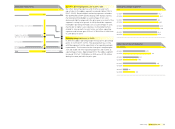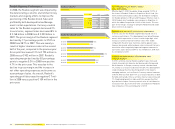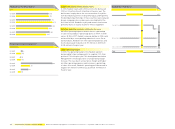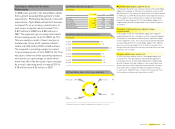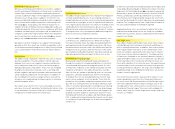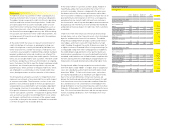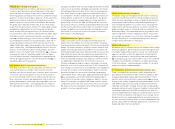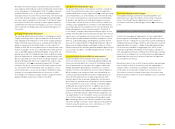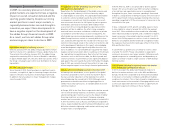Reebok 2008 Annual Report Download - page 114
Download and view the complete annual report
Please find page 114 of the 2008 Reebok annual report below. You can navigate through the pages in the report by either clicking on the pages listed below, or by using the keyword search tool below to find specific information within the annual report.
110 Group Management Report – Our Financial Year Risk and Opportunity Report
Industry consolidation risks
The adidas Group is exposed to risks from market consolida-
tion and strategic alliances amongst competitors and /or retail-
ers. This can result in a reduction of our bargaining power, or
harmful competitive behaviour such as price wars. Abnormal
product discounting and reduced shelf space availability from
retailers are the most common potential outcomes of these
risks. Sustained promotional pressure in one of the Group’s
key markets could threaten the Group’s sales and profi tability
development.
To moderate this risk, we are committed to maintaining a
regionally balanced sales mix and continually adapting the
Group’s distribution strategy.
The economic slowdown in 2008 and negative outlook for 2009
may put further pressure on the sporting goods industry to
consolidate. Several retailers and competitors released declin-
ing sales and earnings and reported fi nancial diffi culties during
the year. Therefore, we now see risks from market consolida-
tion as having a high likelihood of occurrence. We continue to
view the potential impact on both Group sales and profi tability
as medium.
Political and regulatory risks
Political and regulatory risks include potential losses from
expropriation, nationalisation, civil unrest, terrorism and
signifi cant changes to trade policies. In particular, the adidas
Group faces risks arising from sudden increases of import
restrictions, import tariffs and duties that could compromise
the free fl ow of goods within the Group and from suppliers.
To limit these risks, we proactively utilise a regionally diver-
sifi ed supplier base which establishes a certain protection
against unforeseen changes in regulations and also allows
us to shift production to other countries at an early stage if
necessary see Global Operations, p. 064.
At the end of 2008, nearly all apparel-specifi c safeguard
measures against China have expired based on the World
Trade Organization
(WTO) accession agreements. However,
due to the current
general economic climate, there are ten-
dencies amongst various governments to seek protection
against imports by applying trade defence instruments, such
as anti-dumping measures on a broader scale. For example,
in December 2008, Brazil opened a formal anti-dumping
investigation into certain footwear originating in China. Simi-
larly, since October 2008,
the EU Commission is reviewing
the existing anti-dumping measures against leather-upper
footwear from China and
Vietnam upon request of a group of
footwear producers. During the investigation period, which is
expected to last for most of 2009, the existing anti-dumping
duties remain in place. The majority of our offering is techni-
cal athletic footwear. As these products are not affected by the
measure, the current fi nancial impact is minor and we have
adapted our sourcing activities accordingly.
With regard to the medium-term risks of regulatory actions,
we still continue to expect a carefully and interest-balanced
global trade policy by the governments. One such example in
the USA are potential new regulations pertaining to the pre-
clearance and potential scanning of all transport containers
at foreign ports prior to departure/arrival in the USA. These
may require additional infrastructure investments to make
our Group compliant with these initiatives. However, we do not
expect the fi nancial implications to be overly signifi cant beyond
the initial investment in systems to comply with the regula-
tions. Therefore, we continue to regard the medium-term risk
of further political and regulatory actions as having a low prob-
ability of occurrence. Nevertheless, an unexpected signifi cant
change in the political and regulatory environment could have
a medium potential fi nancial impact.
Legal risks
The adidas Group is exposed to the risk of claims and litigation
for infringement of third-party trademark, patent and other
rights. To reduce this risk, new product technologies, designs
and names are carefully researched to identify and avoid
potential confl icts with the rights of third parties. We have
strengthened our Intellectual Property department resources
to drive further enhancements in our patent portfolio, and in
the reviewing and analysis of third-party patents.
Due to the safeguards in place, we believe there continues to be
a low likelihood of our Group infringing third-party trademark
or patent rights in a material way. Nevertheless, we continue
to believe that litigation could have a medium fi nancial impact
on our Group.
Risks from product counterfeiting and imitation
As popular consumer brands which rely on technological and
design innovation as defi ning characteristics, the Group’s
brands are a frequent target for counterfeiting and imitation.
To reduce the loss of sales and the potential reputation dam-
age resulting from counterfeit products sold under our brand
names, the adidas Group makes use of extensive legal protec-
tion (generally through registration) and works closely with law
enforcement authorities, investigators and outside counsel.
Although we have stepped up measures such as product secu-
rity labelling with our authorised suppliers, continued develop-
ment of these measures remains a high priority for 2009 and
beyond.
Over eight million counterfeit adidas Group products were
seized worldwide in 2008 (2007: over seven million). In
addition, the adidas brand was awarded a positive judgement
in a US lawsuit for imitation of the 3-Stripes trademark. This
judgement is now under appeal by the opposing party. Two
other lawsuits with major US retailers were settled amicably.
We continue to regard the likelihood of sustained counterfeiting
and imitation as high in the short and medium term. However,
we believe we have adequate costs budgeted to support our
ongoing efforts to successfully combat counterfeiting and
imitation. We continue to assess the potential risk of counter-
feiting and imitation to negatively impact our forecasted
fi nancial contribution as low.



